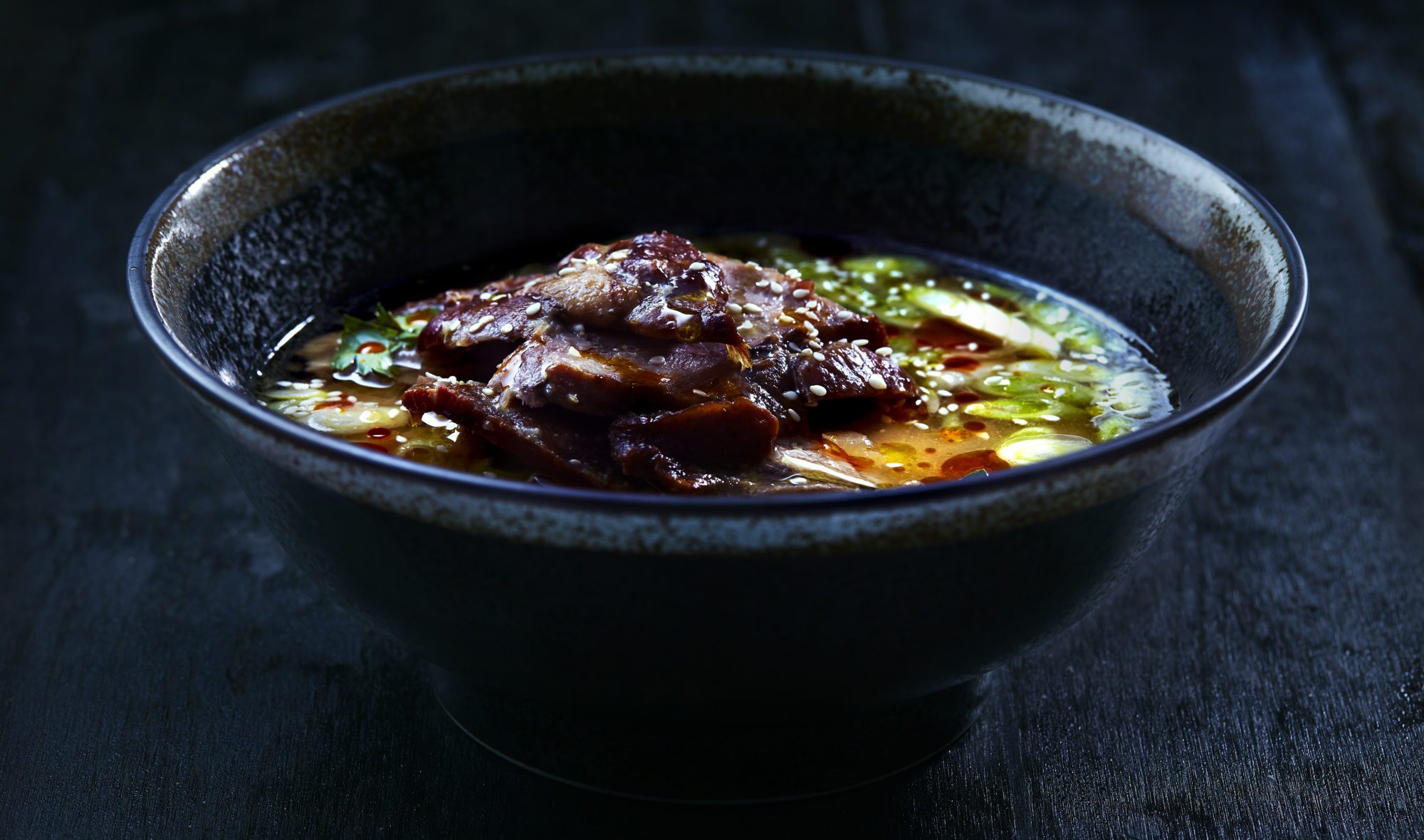Ham


Ham is preserved pork, typically from the hind leg of the pig. Curing methods include salting, smoking, and brining. Ham is pink to reddish in color, often with streaks of white fat, the proportion and distribution depending on the variety. Generally, it has a robust salty, meaty, slightly smoky taste, and a tender, luxurious mouthfeel. Ham is a rich source of protein, zinc, and selenium, but it’s also very high in sodium. Ham is enjoyed all over the world: Regional specialties include Westfalian ham in Germany, York ham in the UK, Smithfield ham in the United States, Prosciutto in Italy, Anfu ham in China, and others. Sodium nitrate is the most controversial component of ham, as it can be converted to nitrosamines during the processing, storage, or cooking process, and nitrosamines are linked to higher rates of cancer. Therefore, ham is best eaten as a special treat, perhaps wrapped around a fresh slice of melon.
Ham is preserved pork, usually from the hind leg of the pig. Less commonly, it can also be made from boar or bear meat.
Ham has been made since Roman times, although it used to be reserved only for royalty or very special occasions. You would not have found it casually floating in a commoner’s bowl of split pea soup.
These days, ham is enjoyed all over the world, and is available to non-royalty too! Regional specialties include Westfalian ham in Germany, York ham in the UK, Smithfield ham in the United States, Prosciutto in Italy, Anfu ham in China, and others.
Traditional methods of making ham would take weeks. Makers would steep the ham in brine for several weeks, and then use real smoke to slow cook it over the course of many hours.
Modern methods only take a few days. Manufacturers speed up the brining process by injecting (rather than steeping) the ham with a brine solution that typically includes water, salt, sugar, spices, sodium phosphate, sodium erythorbate, and sodium nitrate. The salt, sugar, and spices preserve and flavor the ham; the sodium phosphate increases the retention of the brine solution and tenderizes the meat; the sodium nitrate helps retain the pink color of the ham, and also inhibits bacterial growth; and the sodium erythorbate stabilizes the color.
Sodium nitrate is the most controversial component of ham, as it can be converted to nitrosamines during the processing, storage, or cooking process, and nitrosamines are linked to higher rates of cancer. Therefore, ham is best eaten as a special treat.
Ham can be found ready-to-serve, fresh, or cured.
Ready-to-serve ham has been steeped in (or more commonly in modern food production, injected with) brine, and then steamed, boiled, or smoked to cook it through. Depending on the variety of ham and the flavor being achieved, the ham may then be further smoked or seasoned to make the final product even more tender and savory.
Fresh ham has been pre-cooked just long enough so that harmful bacteria are destroyed. However, it must be further cooked before being eaten.
Cured ham is first rubbed generously with salt and then dried. It is ready to eat as-is.
Ham is sold as a whole leg with the bone in, as a partial leg with or without bone, or sliced in various ways. It is pink to reddish in color, often with streaks of white fat, the proportion and distribution depending on the variety. Generally, it has a robust salty, meaty, slightly smoky taste, and a tender, luxurious mouthfeel.
Ham can also come in specialty varieties, as identified by its label. Many jurisdictions strictly control the term “ham” along with any regionally specific names. In the United States, for instance, ham can only refer to meat from the hind leg of the pig, and Smithfield ham must come from a specific region of Virginia or North Carolina, and be cured according to a particular method.
In other words, ham can be very fussy.
A 3.5 ounce serving of ham (about 100g) contains 133 calories, 17g of protein, 6g of fat (2g of which is saturated fat), and 1g of carbohydrates. (These numbers will of course vary depending on the variety and fat content of the type of ham you get.)
Ham is a good source of zinc and selenium.
Like all processed meats, ham is very high in sodium, with a single serving representing 50% of your daily requirement. It’s also high in cholesterol.
Most modern curing methods involve the use of nitrites, which are added along with salt. Nitrites prevent bacterial growth, add flavor, and give ham its appealing pink or reddish color. However, nitrites may also be toxic in large amounts, and regular consumption of processed meats have been linked to cancer. Therefore, it is probably best to limit your consumption of ham (and other processed meats).
Ham is available year round. Look for firm, tightly grained pink flesh, and consult best-before dates on labels for the freshest product.
If you are looking for a specific type of ham, check the labels or ask your butcher.
Cured hams will keep in a cool, dry place for a couple of months. But most people keep ham in the refrigerator. Ready-to-serve or fresh ham must be refrigerated.
A whole or partial leg will keep a little longer than sliced ham. Keep sliced ham in its original wrapping in the fridge for about a week.
In most cases, there’s no need to cook ham; you can simply slice it and serve. The only exception is fresh ham, which needs to be cooked further before being eaten. (Directions are below.)
However, all forms of ham can be further roasted, fried, or grilled if desired. This can transform the texture and flavor in pleasing ways, caramelizing and crisping the final product. Ham can also be added to other dishes as a flavoring agent, much as you might use bacon. This might be one of the safest ways to enjoy ham.
Ham pairs well with many other flavors. It’s delicious with fruits such as apples, melons, pineapple, and cranberries. It’s also good with barbecue sauce, soy sauce, mustard, horseradish; maple syrup, brown sugar, honey; and vegetables, including sweet potatoes, potatoes, asparagus, legumes, and many more.
To bake a 5 lb ham, preheat your oven to 325 degrees Fahrenheit. Line a baking pan with foil. Score the meat and insert cloves (or garlic cloves) into the scored places. On the stovetop, melt ⅔ cup butter together with 2 cups honey and ¼ cup maple syrup. Brush the meat with this glaze. Bake for an hour and 15 minutes, basting every 15 or 20 minutes. During the last five minutes of cooking, turn on the broiler to caramelize the glaze. Let the meat rest for 5 or 10 minutes before serving.
Another option is to make a paste of dijon mustard and honey. Paint your ham with this paste, and roast as described, basting with extra paste every 20 minutes.

Have you ever tried adding ham to miso soup? If not, you're missing out. The marinated ham in this recipe adds an extra punch of flavor to miso soup. it's a must try!
Prep Time: 30 minutes Cook Time: 300 minutes Yield: 4 bowls of soup
For the marinade:
Mix the marinade ingredients together to form a loose paste. Add as much orange juice as you like to loosen if needed.
For the ham:
Note: It’s preferable that the ham is a fresh leg from a piglet. Sometimes this is difficult to find but this recipe is adaptable to other pork products, like leaner roasts. If you are getting a ham leg from a butcher it is up to you whether or not you keep the skin on. If you wish to remove the skin, ask your butcher to do this for you. Otherwise, you can cook the ham with the skin on and remove it with ease after cooking.
Add the ham leg to a bag and add in the marinade. Massage the ham inside the bag. Put the ham into the fridge overnight.
Pull the ham out of the fridge about one hour before cooking. Roast the ham in a preheated 250 degree Fahrenheit oven for about 3 to 4 hours or until the ham leg has an internal temperature of 160 degrees Fahrenheit. When done, turn the heat up to 450 degrees Fahrenheit, and roast for about 20 minutes or until the exterior of the ham appears crispy and has turned a nice deep brown.
For the soup:
While the ham is roasting, prepare the soup.
Put a medium soup pot on a burner set to medium heat. Add the oil and heat through. Add in the onions and adjust the heat as needed (you may need to lower the heat slightly if onions appear to be searing). Cook the onions until they appear translucent and a tad brown. Add in the miso and mix with the onion. Caramelize the miso for a few minutes. Add in the thyme and the stock. Using a whisk, mix to combine the miso and the liquid. Next, add in the garlic, soy sauce, and fish sauce. Bring to a boil and then reduce the heat to a simmer. Cook the soup for 30 minutes to an hour, leaving it slightly covered.
For the assembly:
Get four soup bowls out of the cupboard. Add some broth to each bowl, add in some sliced ham, your garnishes of choice, and finally add a soft boiled egg to each bowl.
Serve immediately.
Enjoy!
Precision Nutrition’s Encyclopedia of Food expands every single month as we highlight new foods and showcase beautiful food photography. If you’d like to stay up to date, simply click this link. From there, we’ll send you a FREE copy of our recipe book. We’ll also let you know when new and delicious foods are added to the site.
Ham is preserved pork, typically from the hind leg of the pig. Curing methods include salting, smoking, and brining. Ham is pink to reddish in color, often with streaks of white fat, the proportion and distribution depending on the variety. Generally, it has a robust salty, meaty, slightly smoky taste, and a tender, luxurious mouthfeel. Ham is a rich source of protein, zinc, and selenium, but it’s also very high in sodium. Ham is enjoyed all over the world: Regional specialties include Westfalian ham in Germany, York ham in the UK, Smithfield ham in the United States, Prosciutto in Italy, Anfu ham in China, and others. Sodium nitrate is the most controversial component of ham, as it can be converted to nitrosamines during the processing, storage, or cooking process, and nitrosamines are linked to higher rates of cancer. Therefore, ham is best eaten as a special treat, perhaps wrapped around a fresh slice of melon.